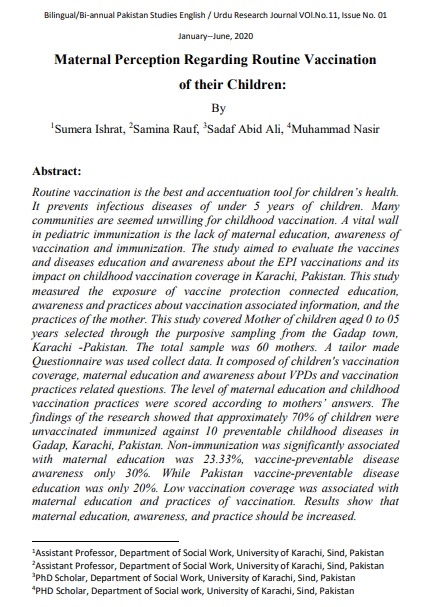Maternal Perception Regarding Routine Vaccination of their Children:
Keywords:
Vaccination Coverage, Routine Vaccination, Maternal, Education, practices, childhood.Abstract
Routine vaccination is the best and accentuation tool for children’s health.
It prevents infectious diseases of under 5 years of children. Many
communities are seemed unwilling for childhood vaccination. A vital wall
in pediatric immunization is the lack of maternal education, awareness of
vaccination and immunization. The study aimed to evaluate the vaccines
and diseases education and awareness about the EPI vaccinations and its
impact on childhood vaccination coverage in Karachi, Pakistan. This study
measured the exposure of vaccine protection connected education,
awareness and practices about vaccination associated information, and the
practices of the mother. This study covered Mother of children aged 0 to 05
years selected through the purposive sampling from the Gadap town,
Karachi -Pakistan. The total sample was 60 mothers. A tailor made
Questionnaire was used collect data. It composed of children's vaccination
coverage, maternal education and awareness about VPDs and vaccination
practices related questions. The level of maternal education and childhood
vaccination practices were scored according to mothers’ answers. The
findings of the research showed that approximately 70% of children were
unvaccinated immunized against 10 preventable childhood diseases in
Gadap, Karachi, Pakistan. Non-immunization was significantly associated
with maternal education was 23.33%, vaccine-preventable disease
awareness only 30%. While Pakistan vaccine-preventable disease
education was only 20%. Low vaccination coverage was associated with
maternal education and practices of vaccination. Results show that
maternal education, awareness, and practice should be increased.
References
Achieving Polio Eradication. (n.d): A Review of Health Communication
evidence and lessons learned in India and Pakistan. Retrieve from
http://www.who.int/bulletin/volumes/87/8/08-060863/en/ on July 7,
Afzal U, Yusuf A. (2013). The State of Health in Pakistan: An overview:
The Lahore Journal of Economics;18(special edition) P:233
Benin AL, Wisler-Scher DJ, Colson E, Shapiro ED. (2006). Holmboe ES:
Qualitative analysis of the mother's decision-making about vaccines
for infants: the importance of trust. Paediatrics.117: 1532-41.
1542/peds.2005-1728. Retrieve from ArticlePubMedGoogle
Scholar on August 23, 2017.
Black RE, Morris SS, Bryce J. (2003). Where and why are 10 million
children dying every year. The Lancet. Jun 28;361(9376):2226-34.
Black RE, Cousens S, Johnson HL, Lawn JE, Rudan I, Bassani DG, Jha P,
Campbell H, Walker CF, Cibulskis R, Eisele T. (2010 Jun 11). Gobal,
regional, and national causes of child mortality in 2008: A Systematic
Analysis, The Lancet, 375(9730) P.p 1969-87.
Cockcroft, A., Usman, M. U., Nyamucherera, O. F., Emori, H., Duke, B.,
Umar, N. A., & Andersson, N. (2014). Why children are not
vaccinated against measles: a cross-sectional study in two Nigerian
States. Archives of Public Health,72(1). doi:10.1186/2049-3258-
-48
Data, statistics and graphics. Retrieve from
http://www.who.int/immunization/monitoring_surveillance/data
/en/ on October 12, 2015.
Gadap Town: largest, but the least developed. Retrieved from
https://www.dawn.com/news/151065 on Nov 6, 2016.
Encyclopedia of the Nations. (2007). Asia and Oceania. Pakistan. Pakistan
Health. (Online). Retrieve from
http://www.nationsencyclopedia.com/Asia-and-Oceania/PakistanHEALTH.html.UNICEF on Dec 23, 2014
Heininger U (2006) an internet-based survey on parental attitudes towards
immunization. Vaccine. 24: 6351-5.
1016/j.vaccine.2006.05.029.Retrieve from
ArticlePubMedGoogle Scholar on February 10, 2017
Holdsworth, C., & Robinson, J. E. (2008). ‘I've never ever let anyone hold
the kids while they've got ciggies’: moral tales of maternal smoking
practices. Sociology of Health & Illness, 30 (7), 1086-1100. Do:
1111/j. 1467-9566.2008.01102
Infant Mortality. Retrieve from http://www.who.int/gho/child
_health/mortality/neonatal_infant_text/en/ on March 7, 2017
Infant mortality. (n.d.). Retrieved from http://www.who.int/ gho/child
_health /mortality/neonatal_infant_text/en/ on March 08, 2018.
Islam A. (2002). Health Sector Reform in South Asia: New Challenges and
Constraints. Health policy:60(2):151-69.
Kabir M, Iliyasu Z, Abubakar IS, Gajida AU. (2005). Knowledge,
perception , and belief about childhood immunization and attitude
toward uptake of poliomyelitis immunization in a Northern Nigerian
Village. Annals of Nigerian Medicine1: 21-26.
Ministry of Health (2010), Expanded Programme on Immunization
Retrieve from
http://202.83.164.26/wps/portal/Moh/!ut/p/c0/04_SB8K8xLLM9M
SSzPy8xBz9CP0os3h_Nx9_SzcPIwP_MAsDA6MQL3NXtxBvIw
NzA_2CbEdFAOW90ZM!/?WCM_GLOBAL_CONTEXT=/wps/
wcm/connect/MohCL/ministry/home/sahomegeneral/sageneralrigh
t/a_expanded+program+on+immunization on February5, 2010.
Neonatal Mortality - UNICEF DATA, Retrieve from
https://www.unicef.org/publications
/files/Child_Mortality_Report_2017.pdf on June 24, 2018
Nizar H, Chagani P. (2016). Analysis of Health Care Delivery System in
Pakistan and Singapore. International Journal of Nursing: 8(2).
Payne S, Townend J, Jasseh M, Lowe Jallow Y and Kampmann B. (Mar
. Achieving comprehensive childhood immunization: an
analysis of obstacles and opportunities in The Gambia. Health
Policy Plan. 29(2): 193–203. doi: 10.1093/heapol/czt004
Polio Cases in Provinces. Retrieve from
http://www.endpolio.com.pk/polioin-pakistan/polio-cases-inprovinces on October 25, 2017
Rutherford ME, Dockerty JD, Jasseh M, et al. (2009). Preventive measures
in infancy to reduce under-five mortality: a case-control study in the
Gambia. Tropical Medicine and International Health; 14:149–55.
Sultana A, Jahan S and Ahmad I. (2001). Knowledge, Attitude and Practice
of immunization in an urban population. Pak Armed Forces Med J;
: 177-81.
The Gale Group Inc. (2018). Infant and Child Mortality. Retrieve from
April13, 2015
Tomes, H. In the Public Interest: Our children are particularly vulnerable at
this time. PsycEXTRA Dataset. Doi: 10.1037/e312492004-027
Tribune Retrieve from https://tribune.com.pk/story/1368971/low-rateroutine-immunisation-prevails-karachis- slums/ on September 8,
Unicef State of the world's children. (2006). Oxford: Oxford University
Press.
Vander Stoep, S. W., & Johnston, D. D. (2009). Research methods for
everyday life: blending qualitative and quantitative approaches. San
Francisco: Jossey-Bass. pp 48.
World Health Organization. (1974) World Health Assembly Fourteenth
Plenary Meeting. Handbook of Resolutions. Geneva: World Health
Organization.
Wiysonge CS, Uthman OA, Ndumbe PM, and Hussey GD. (2012).
Individual and Contextual Factors Associated with Low Childhood
Immunization Coverage in Sub-Saharan Africa: A Multilevel
Analysis. PLoS ONE, 7 (5): e37905. doi:
1371/journal.pone.0037905.
WHO. vaccine-preventable diseases: monitoring system. (2010). 2010
global summary. Geneva, Switzerland: World Health Organization.
Retrieve from from;whqlibdoc.who.int/hq/201
/WHO_IVB_2010_eng.pdf? ua=1. On March 11, 2017



